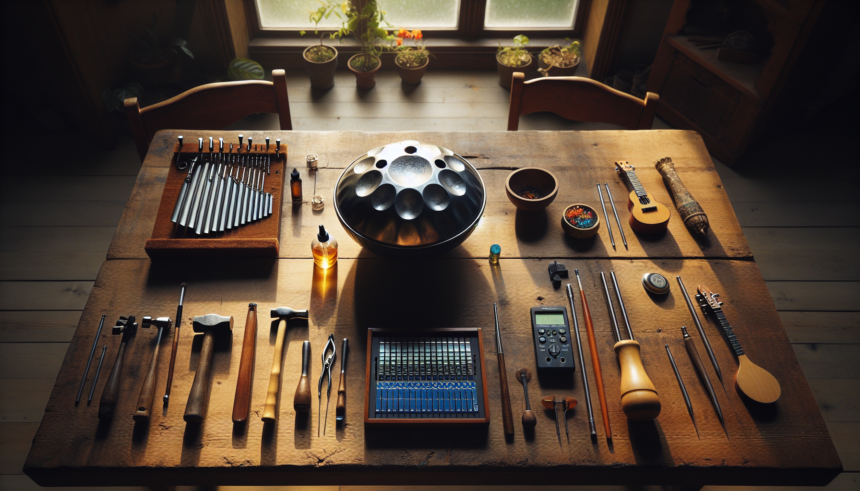<!DOCTYPE html>
<html lang="en">
<head>
<meta charset="UTF-8">
<meta name="viewport" content="width=device-width, initial-scale=1.0">
<title>Handpan Tuning for Beginners</title>
</head>
<body>
<article>
<header>
<h1>Handpan Tuning for Beginners: Getting Started with Basic Tools and Techniques</h1>
</header>
<section>
<p>The handpan is a captivating musical instrument known for its ethereal sound and minimalist design. However, behind its seemingly simple appearance is a sophisticated sound structure that requires proper tuning to maintain its enchanting tone. For beginners, understanding handpan tuning can be daunting, but with some guidance, you can effectively manage this aspect of instrument maintenance. This article walks you through the essentials of handpan tuning, including the necessary tools and techniques.</p>
</section>
<section>
<h2>Understanding the Mechanics of a Handpan</h2>
<p>Before diving into tuning techniques, it's important to understand the basic structure of a handpan. A handpan typically features a central note, called the "ding," and a series of up to nine other notes arranged around it, known as the "tone-fields." Each tone-field is carefully crafted to produce a specific pitch. Unlike conventional instruments, a handpan lacks adjustable parts and relies solely on its metal body to produce sound. Therefore, maintaining the correct shape and tension of the metal is crucial to preserving its desired pitch.</p>
</section>
<section>
<h2>When to Tune Your Handpan</h2>
<p>Tuning is essential to preserve the handpan's unique sound quality. However, identifying when your handpan needs tuning can be tricky, especially for beginners. Consider tuning your handpan if:</p>
<ul>
<li>The sound quality has altered, displaying a ‘tinny’ or ‘out of tune’ resonance.</li>
<li>There are visible dents or warps on the tone fields.</li>
<li>The handpan sustains damage from a fall or impact.</li>
<li>You notice a difference in pitch when compared to recordings or other well-tuned instruments.</li>
</ul>
<p>Regular assessment of your handpan's condition can help maintain its sound integrity and prolong its lifespan.</p>
</section>
<section>
<h2>Basic Tuning Tools for Beginners</h2>
<p>Tuning a handpan requires some specialized tools. While expert tuners may use a variety of sophisticated equipment, beginners can start with a few basic tools:</p>
<ul>
<li><strong>Hammer:</strong> A light-weight hammer with a non-metallic head (often rubber or leather) to gently adjust the tone-fields without damaging the metal.</li>
<li><strong>Tuner App:</strong> A reliable digital tuner app to detect and measure the pitch of each note. Many apps are available for smartphones that can accurately pick up the notes produced by the handpan.</li>
<li><strong>Protective Padding:</strong> Soft padding or blankets to protect the handpan from impacts during the tuning process.</li>
<li><strong>Frequency Chart:</strong> A chart or reference material that outlines the desired frequencies for the specific tuning of your handpan.</li>
</ul>
<p>Gathering these tools will prepare you to embark on your handpan tuning journey.</p>
</section>
<section>
<h2>Basic Handpan Tuning Techniques</h2>
<p>Tuning your handpan involves reshaping and adjusting the tension on the tone-fields. Here’s a simple guide to get you started:</p>
<h3>1. Preparation</h3>
<p>Start by setting up a quiet workspace free from distractions. Place the handpan on a stable and cushioned surface to prevent further damage during the process. Have your tuner app ready.</p>
<h3>2. Understanding Notes and Frequencies</h3>
<p>Familiarize yourself with the current tuning structure of your handpan. Use the frequency chart to identify the correct frequency of each note. This will serve as a guide during the tuning process.</p>
<h3>3. Assessing the Pitch</h3>
<p>Using your digital tuner, assess the current pitch of each tone-field on your handpan. Make a note of any deviations from the desired frequency.</p>
<h3>4. Adjusting the Tone-Fields</h3>
<p>Use your hammer to gently tap the edges of a tone-field to either raise or lower its pitch. It's essential to tap lightly and consistently, as heavy hits can damage the instrument. Aim to make small adjustments, checking the pitch with the tuner app after each tap.</p>
<h3>5. Fine-Tuning</h3>
<p>Once the general pitch adjustment is complete, focus on fine-tuning. Small variations in pitch can have a significant impact on the overall sound. Continue making minor adjustments until each tone-field aligns closely with its target frequency.</p>
</section>
<section>
<h2>Tips for Successful Tuning</h2>
<p>Here are some tips to aid you in the tuning process:</p>
<ul>
<li><strong>Be Patient:</strong> Tuning takes time, especially when you are new to the process. Rushing can lead to mistakes or damage.</li>
<li><strong>Regularly Check Pitch:</strong> Continuously monitor pitch using your tuner app after every adjustment to track progress and avoid over-altering the tone-fields.</li>
<li><strong>Practice Consistency:</strong> Apply consistent pressure and repeated patterns when tapping to ensure uniform sound production.</li>
<li><strong>Maintaining Instrument Quality:</strong> Regularly maintain your handpan by keeping it clean and protected to reduce the frequency of tuning needs.</li>
<li><strong>Seek Guidance:</strong> If in doubt, reach out to experienced tuners or online communities for advice and troubleshooting tips.</li>
</ul>
</section>
<section>
<h2>Conclusion</h2>
<p>Tuning a handpan is both an art and a science that demands attention, patience, and practice. By utilizing basic tools and familiarizing yourself with elementary tuning techniques, you can begin your journey into the rewarding world of handpan musicianship. Remember, the goal of tuning is to realign your instrument with its inherent harmonious potential, allowing every note to resonate deeply and beautifully. Though the process may seem daunting initially, persistence and dedication can lead to mastery and enhance the overall handpan playing experience.</p>
</section>
<section>
<h2>FAQs</h2>
<h3>1. Can I tune my handpan at home without prior experience?</h3>
<p>Yes, with the right tools and guidance, beginners can start to tune their handpans at home. Start with minor adjustments and gradually gain confidence as you become familiar with the process.</p>
<h3>2. What if I accidentally detune a note?</h3>
<p>If you accidentally detune a note, slowly work to correct it using your digital tuner as a guide. Always make minor adjustments to avoid over-correction.</p>
<h3>3. How often should a handpan be tuned?</h3>
<p>Tuning frequency depends on various factors, including usage, storage conditions, and whether the instrument has sustained damage. Regular checks can determine when tuning is needed.</p>
<h3>4. What if my handpan is severely damaged?</h3>
<p>If your handpan is severely damaged, it is recommended to seek professional help to prevent further harm. Professionals have the expertise and tools to address significant issues effectively.</p>
<h3>5. Are there any alternative tuning methods?</h3>
<p>Alternative methods like electronic tuning tools exist but often require advanced knowledge and experience. Beginners are advised to start with basic techniques before exploring complex methods.</p>
</section>
</article>
</body>
</html>Handpan Tuning for Beginners: Getting Started with Basic Tools and Techniques

Leave a comment




